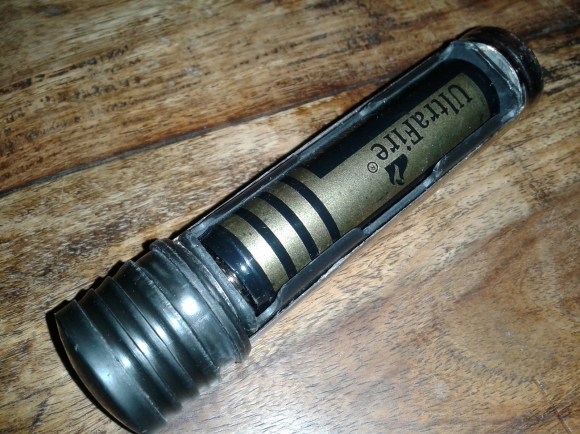
If you’re familiar with VersaPak tools you’ll note that while the battery pack in this image looks somewhat familiar, it’s not supposed to have a removable cell. This is [Martin Melchior’s] hack to use laptop 18650 Lithium cells with VersaPak tools.
The original NiCad packs used three cells for a total of 3.6V, so it is possible to substitute a Lithium cell in the same voltage neighorhood. The tools are pretty hard on the battery packs, drawing a lot of current in certain situations. But these cells are being harvested from dead laptop battery packs so it’s not a huge concern if their life is a bit shortened.
The hack places an 18650 battery receptacle inside of the VersaPak battery housing. There’s a bit of careful disassembly to get to this point, but it’s well illustrated in [Martin’s] project log. And of course you’ll need to use a proper Lithium battery charger from here on out.
This form factor has been popping up in a lot of hacks lately. Here’s another one that modifies the Goal Zero Bolt flashlight to use them.
















Yeah, well he didn’t pull that ultrafire from a laptop pack. Ultrafire and any other xxxxfire batteries are cheap chinese crap. You really shouldnt abuse these cheap batteries, there are cases of them exploding under high draw on some flashlight forums. Also their stated capacity is a total lie.
Go for some name brand cells such as panasonic.
http://www.fasttech.com/products/1420/10001980/1345500
I think the reason the OP referred to the 18650 as a “laptop” cell is more because laptops use said form factor for the cells.
But yeah, the *fire brand of batteries are absolutely terrible. If I recall correctly, the black-and-gold UltraFire brand of batteries have a labeled capacity of 4000 mAh but in reality holds only 2000 mAh [1].
The Panasonic batteries are pretty damn awesome. I have some that I scrapped from an older laptop of mine (some CGR18650CGs) and they are my favourite cells to work with. I also recently bought some NCR18650s that is rated at 3400 mAh [2]! I’ve yet to receive them in the mail but reviews are pretty promising. I’m quite tempted to rebuild my worn-out 12-cell HP battery with these cells (but it won’t be cheap!).
On another note, I’m not sure how much current the tool draws but the wires that came with the original holder might be a bit too thin.
[1] http://lygte-info.dk/review/batteries2012/UltraFire%20BRC18650%204000%20mAh%20%28Brown-Gold%29%20UK.html
[2] http://lygte-info.dk/review/batteries2012/Panasonic%20NCR18650B%203400mAh%20%28Green%29%20UK.html
Most of the *fire batteries aren’t bad, they are overrated but that doesn’t automatically make them bad.
In fact i have seen a distinct quality increase in batteries from cheap manufacturers, both lose cells and replacement battery packs. They no longer die in a few weeks and while they are usually between 60 and 90% of the capacity of a new branded battery they are also between 60 and 90% cheaper.
I’m still not one who’s happy with a battery that has a blatant lie on the label.
I bought a 4-pack of UltraFire “3000” mAh cells about a year ago. According to this test (http://lygte-info.dk/review/batteries2012/UltraFire%20BRC18650%203000mAh%20%28Red-silver%29%20UK.html) the 2 amp discharge test gave a capacity of 2.2 Ah, but my own test on them brought me somewhere near the 0.9-1.4 Ah range. Internal resistance ranged from 700 milliohms, all the way to 1.8 ohms.
I’d rather spend more on a quality cell than gamble on some cheaper cells with inconsistent or poor performance, but that’s just me.
As an engineer who works with custom lithium ion packs, you should never be using them without protection circuits. Commonly, you’ll see circuits that include overvoltage and undervoltage protection, at least. Overcharging the pack (in the event that the charger doesn’t work properly) can cause the cells to fail catastrophically. Discharging the cells too far can permanently damage them. If you want more protection, you start adding current limits, temperature limits for charge and discharge, and a bunch of other stuff (mostly for multicell packs, though).
Even the cheap lithium polymer packs that Sparkfun cells have a tiny, built-in circuitboard for basic protection features. For 18650-sized cells, you can get ones that have a tiny circular PCB (the same diameter as the cell) mounted on the end with a protection circuit.
Those Ultrafire batteries actually are salvaged batteries – most likely from bad laptops battery packs. If you look closely you still can see the welding marks where the tin fans were attached.
I had a couple of those “4000mAh” batteries. NONE of them got over 1200mAh, half of them delivered just about 500mAh. Once in a while you may get lucky, but then again you don’t know anything about its history. These batteries are dangerous, cheap and expensive crap (any price for this improperly recycled.chemical waste is too high).
I had a couple of those “4000mAh” Ultrafire batteries (I was young and naive and didn’t know better). NONE of them got over 1200mAh, half of them delivered just about 500mAh. Once in a while you may get lucky, but then again you don’t know anything about their history. These batteries are dangerous, cheap and expensive crap (any price for this cheaply disposed shrink-wrapped chemical waste is too high).
Those Ultrafire batteries definitely are salvaged batteries (added with a simple protection-pcb and put in new shrink-wrap) – most likely from bad laptops battery packs. If you look closely you still can see the welding marks where the tin fans were attached.
Major improvements in 18650 cells since this article was written. Some are capable of high-amp output with high ampacity…e.g. TRUE 3Ah to 5Ah.
Good and PRACTICAL/REAL-WORLD info on these is available at the electric-skateboard.builders website.